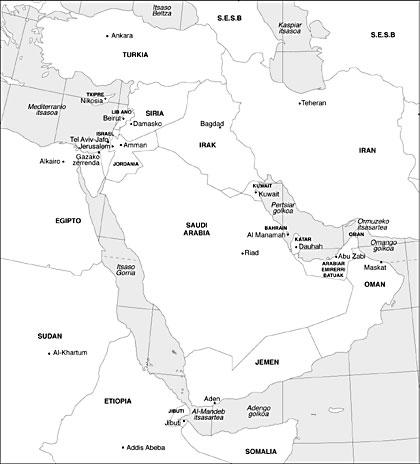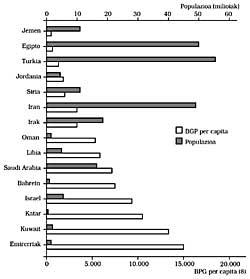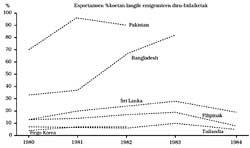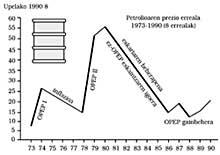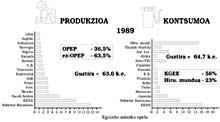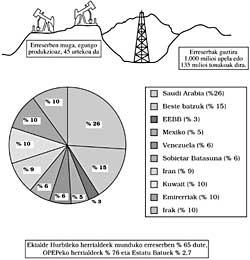The oil war, an example for the 1990s?
1991/07/01 Zurbano, Mikel Iturria: Elhuyar aldizkaria
War of information
One of the most important elements for the Gulf conflict is the abundance of media. In turn, this element proposes a new internal logic planned for the development of armed conflicts and a variety of questions to understand reason.
Despite this magnificent diffusion of media and information technologies, the degree of knowledge of the reality of war has been very scarce. Noteworthy is the asymmetry of the information offered (wild attack/surgical operation, etc.). Speaking on one side or on the other) and the desire to mask the massacre of thousands of Iraqi citizens as a gymnastic training exercise.
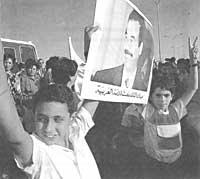
Thus, disinformation and manipulation have intensified as spectacular advances have been demonstrated in the experimentation, development and dissemination of telecommunications applied to the military sphere. We would be facing the transformation of this sector, a new component of the war front. It has fulfilled its concrete goal of entertaining and neutralizing Western public opinion, so important for the internal stability of the allied countries, to remember Vietnam.
In what economic context do we place war?
To better understand the conflict we face, we cannot forget that this war has been placed at the coordinates of world economic evolution towards the global market. From the historical point of view, in this epoch of capitalist development, the most prominent is the process of internationalization of capital (the internationalization of the entire cycle of capital, including the productive system 1).
An era that allows the world market and, therefore, world accumulation. This trend is not total, nor even, of course. In this process, many protectionist tensions are still interspersed, but this situation cannot hide the current hegemony of transnational capital in the world economy.
The main result of this general economic dynamic is, in the first place, the growing polarization between the countries of the Center and the Periphery, at the same time as greater differences of distribution of the world wealth, the exploitation or uncontrolled exploitation of the natural resources, origin of the current ecological crisis, the homogenization of the rules of consumption, the hunger, etc.
To all this we must add the problem of the economic crisis, one of the most important structural explanations of capitalist development. The crisis that develops at the end of the sixties is maintained, although its intensity varies depending on the concrete moment and the country. Before the outbreak of the gulf, for example, most Western countries were in retrograde coordination, always in a context of crisis.
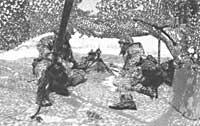
For example, in the United States, production growth in combination with large trade and financial deficits was very low in the first half of 1990. 2. It is tempting to establish a relationship between this situation and the United States' rapid response to the attack on Kuwait. The cooperative revival that the American economy has known at the end of this war reinforces the essence of this hypothesis. The global gendarme function offers, therefore, the possibility of obtaining versatile benefits. Not only in the political sphere, but also in the purely economic sphere, if the financial cost of these benefits is attributed, as in this struggle, to other states.
On the other hand, other new events completely affected the economic-political moment of the pre-war period. On the one hand, the fall of real socialism opened the door to the expansion of the world capitalist system and has meant the destruction of the policy of blocks that regulated the world order after World War II. On the other hand, within the capitalist system appears the reorientation of the International Economic Order. It highlights the new trends in the international distribution of work and the provisional configuration of three geoeconomic zones around the United States, EVE/Germany and Japan.
Therefore, unlike the contextual situation of the two World Wars, on this occasion the conflict has not been proposed as an intercapitalist competition. Again it would be the expression of the sustainability of the economic-political order that establishes hegemony with the South. The lack of autonomy shown by European countries and Japan regarding the US initiative is an absolutely expressive fact. However, the economic profile of this war development coincides with the classic conflicts of imperialist characteristics in which, in addition to the meticulous political objectives, control of raw materials (oil) also has priority.
The Middle East in the world economy
The role of the Middle East in the history of the last years of the world is fundamental to understanding current events in this field. To begin with, since the beginning of this century, it has been a field of tensions and conflicts, after the failure of the Ottoman empire, in which the Western powers and political division have been imposed under them. In addition, the State of Israel has settled in the Palestinian territory, becoming the main source of security and instability in recent decades.
Moreover, from a purely economic point of view, this sphere can be considered part of the periphery of the capitalist system. The internal structuring of local economies is extremely weak. Due to the strong demographic growth, in countries with few resources is even greater, so the large internal immigration current and the strong polarization of income distribution is due to this situation.
If the position of the countries of these territories in the international division of labour is observed, it should be noted that they can be included in the model of the first exporters. In the best situation is the monoproduction of oil and show a strong tendency towards the exterior. It is worth mentioning the differences in the structure of income between countries (especially between countries with oil and without oil), see 1. image) Belonging to social groups.
As has already been mentioned, the difference between countries in these territories generates extreme economic realities, and this is the origin of the current of emigration towards high income states. Given the significant presence of foreign labour, this labour force plays an excellent economic role as a source of income in these territories and in other Asian countries (see figure 2). With regard to the internal differences between rents, the high level of profits of a minority generates a luxury consumption, with which the local private demand shows a great dependence on the outside.
However, the incomes obtained by oil allow certain savings and capitalization. However, internal savings will not be destined to increase its productive capacity, but to recycle itself in the productive and financial system of the capitalist west. Services Services Services
In short, in addition to an exhaustive political and cultural conflict, one must take into account the destabilizing complement of the socio-economic situation of these territories, characterized by a low level of productive development (weak industrialization and oil monoproduction) and by significant differences both human and international.
Oil PLEE (OPEC) and crisis
Energy base Energy base
After World War II, an energy model has been materialized that serves as the basis for economic expansion (and still lasts). Under this model, the standard is the waste of scarce and non-renewable energy resources, and the high energy consumption is completed with the monoculture of the offer.
In this model, the queen of energy sources has been oil, and is still, as the cause of this war indicates. The introduction of the TVCP as an offer poster was the origin of oil price rises from 1973 and 1979. These increases have meant a relative transformation in the dimension and structure of energy production and consumption.
In the field of demand there has been a decrease in energy consumption, while the use of other energy sources, especially nuclear, has increased. As for the supply, fuel production in the UPV countries has decreased and that of other countries has increased, both in the Third World (Mexico, Brazil, India, etc.) as in the West (Britain, Norway, Soviet Union, United States 4, etc. ).
The energy structure in the eighties
As for the structure of energy consumption, it is correlated with fuel pressure, although its demand elasticity is low. Hence, it can be understood that after doubling prices, the capitalist countries reduce the dependence of oil in a relative way.
On the other hand, Figure 4 reflects that the international structure of fuel consumption shows total superiority over the South of the West in the pre-war period. It should be noted that in 1989 the US represented, individually, 20% of the total world oil consumption. Taking as a reference the consumption per capita, a human being of the US consumes twice as much as Japanese or the EEA and twice as much as the average of the Third World.
Given this demand situation, production is affected by these new energy sources, with a strong presence of the nuclear sector. The supply of other oil countries outside the US has increased, reaching 63.5% of the world's total oil production in 1989 and 36.5% of the UPV countries' production (50% in 1973).
The relative slowdown in the supply of UPV/EHU countries does not correspond to another more solid reality of the TVCP in the long term, 76% of world oil reserves. (Figure 5). The same figure shows that in the territories of the Middle East there are 65% of the total world reserves and that the participation of the United States is only 3%.
Oil and War
If we take into account these last numbers and oil reserves (maintaining the current rate of production) have a temporary horizon of 45 years, the importance it has for Western interests in any change of the geostrategic map of this area is evident. This is the first and most superficial cause of the war under study.
On the other hand, the Gulf conflict has increased speculative conduct. Although there are no supply problems, 5, oil price rises have been spectacular as the Gulf tensions last. For example, if the average price of the last day of July 1990 per barrel was twenty dollars, the three of August was 29 and at the beginning of October the price reached 41-42 dollars. From there, there has been a downward trend in the price of oil, which has been reset around twenty dollars to the date of writing of this article due to fluctuations.
Prices similar to those of late July. The oil supply has been maintained or increased. What has happened for the price to rise so much in eight months? The only possible answer is that speculation has taken up again and again. The oligopolist structure of the oil market has a decisive influence on this. Although the data are not available, the accusation of transnational associations with control over the oil distribution system can be considered serialized as the main cause of such conduct.
Special mention should be made of the analysis of why internal incidents of the TVCP occur. In summary, in this institution there are two opposing interests. On the one hand, there are countries with numerous reserves, which consider the quota system established by the TVCP very narrow. These coincide with the Western strategy of maintaining the low level of oil prices, which is also reflected in the political sphere. On the other hand, the efforts of people with less reserves tend to increase their price. In short, the Gulf War has modified the correlation of forces within the PLEE in favor of first-class countries (Saudi Arabia, Kuwait, Emirates, etc. ).
And now what?
Allies Allies Allies
After a clear victory, the logic of force has been imposed. It has been shown again that the legitimacy of the world order lies in violence. They wanted and wanted to show the superiority of the West.
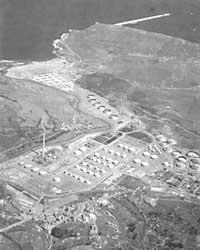
New conditions to increase the distance North-South. There seems to be a big consensus in the West for the US to be gendarme, if there are conflicting interests between the West and the world's poor. In the background is the competition between the countries of the North.
The current situation in the Middle East reflects the size of the human cost of this war. With the disaster of the peoples of Kurdistan and Palestine, a unique ecological impact, strengthening political authoritarianism, economic and financial disstructuring, exile, hunger... While due to the war many internal changes are going to take place in these territories, their dependence towards the outside will only increase, since the forces for greater autonomy have been bankrupt.
In addition, this war has been an example for other Third World countries. As discussed in this article, it is observed that some countries are already suffering the economic consequences of the war, and even if that is hard, it is more worrying to see that reasonable solutions to the serious problems of these States close.
In addition, in the energy sector it seems to have won the bet for the strong solution. Oil and nuclear power have been strengthened as a source of energy if it is not recognized that this restored or hybrid scheme is completely decomposed. It will not be, therefore, surprising that, if the model persists, conflicts of control of energy sources will arise in the future, perhaps milder.
- The internationalization of the productive system has coincided with the consolidation and development of international companies.
- In particular, at this time the growth of production was less than half a point.
- The best known and clear example is the Kuwaitarra group KIO, which has important holdings in companies from different Western sectors.
- It should be mentioned that the behavior of the United States depends on oil pressure. The more expensive the fuel is, the more it is used of its reserves, since when the low price is directed to external production.
- The offer of quotas from Iraq and Kuwait has been covered by other UPV countries since the beginning of the crisis, and in addition the Western territories had already accumulated large oil stocks.

Gai honi buruzko eduki gehiago
Elhuyarrek garatutako teknologia




